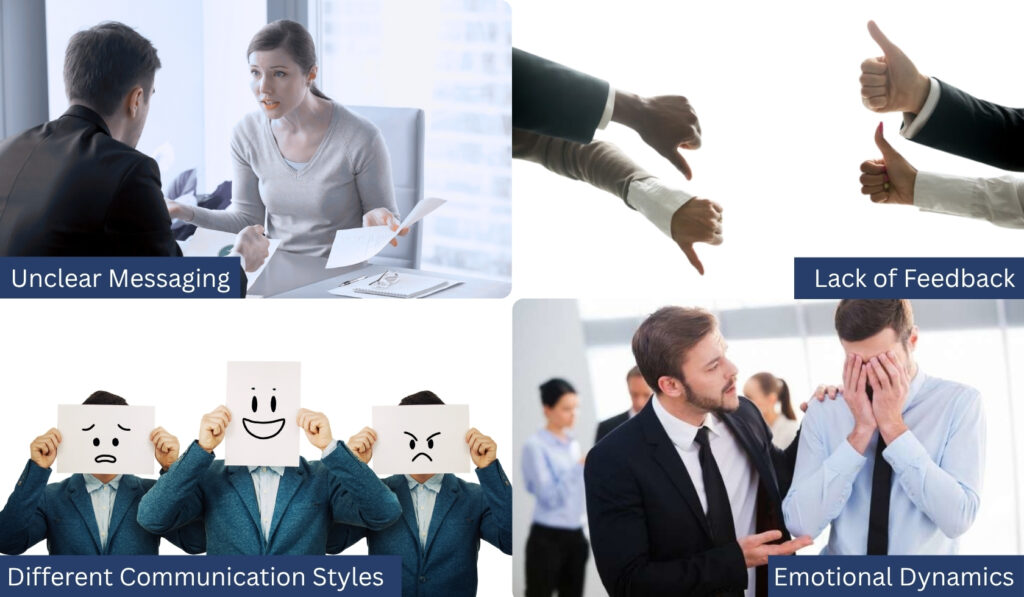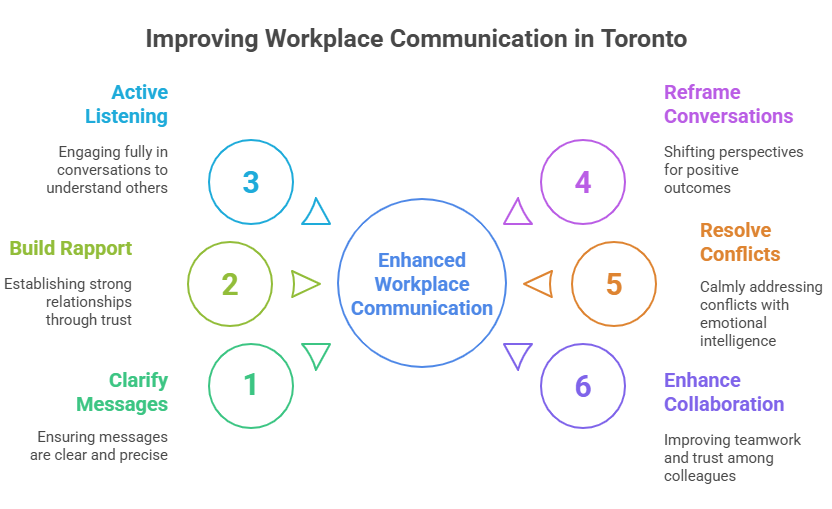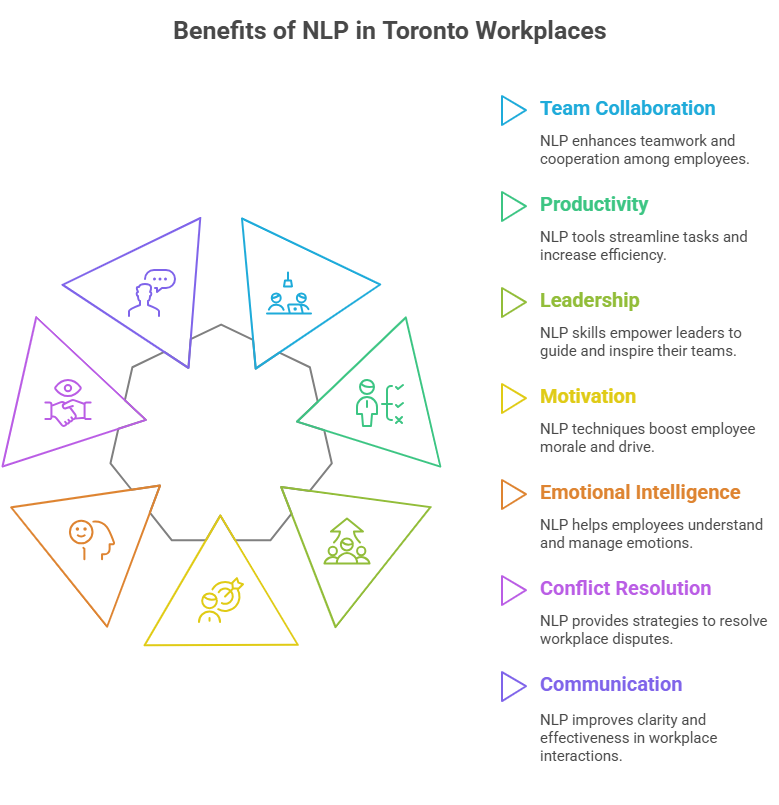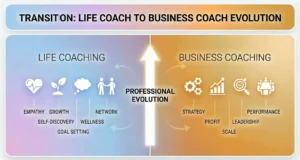Effective communication is the backbone of any successful workplace, yet many Toronto businesses face a challenge. Whether it’s unclear instructions, misunderstandings between teams, or tension in meetings, workplace communication issues can impact productivity and morale.
Imagine if there were a way to smooth out those bumps and make every conversation count. There is! NLP.
NLP is a powerful tool for understanding and improving workplace communication. Its techniques can boost clarity, build stronger relationships, and create a more positive, productive environment. It’s not about changing what you say, but how you say it and how you listen.
In this guide, we’ll explore how NLP can help Toronto companies tackle workplace communication issues and create a more harmonious, efficient, and collaborative work culture.
Common Communication Issues in Toronto Workplaces
Communication breakdowns are a common challenge in many Toronto workplaces, often leading to frustration and misunderstandings. Whether it’s misinterpreting an email, unclear instructions, or difficulty expressing ideas, these challenges can slow down productivity and lower morale. Picture a meeting where everyone’s talking but no one’s really listening this scenario is all too familiar.

Here are a few common communication challenges:
- Unclear Messaging: When instructions or goals aren’t communicated clearly, employees may not know what’s expected of them, leading to mistakes and delays.
- Lack of Feedback: Without regular feedback, employees can feel unsure about their performance or how to improve, leading to disengagement and confusion.
- Different Communication Styles: Team members may have varying preferences for how they communicate, which can create friction if not understood or respected.
- Emotional Dynamics: Misunderstandings and unaddressed tension can negatively impact relationships and decision-making, creating a toxic work environment.
How to Solve Toronto’s Workplace Communication Issues with NLP
Toronto’s workplaces often face communication struggles that slow down progress and create unnecessary tension. Fortunately, NLP offers effective strategies to help teams connect better, improve clarity, and enhance collaboration. Here’s how you can use NLP to solve these common workplace communication challenges:

Clarify Messages with Precision
Misunderstandings often stem from unclear communication. With NLP, you can refine how you deliver your messages to ensure they are specific and easily understood. For example, instead of saying, “Get this done soon,” you could say, “Please complete this task by 3 PM today.” Clear, concise instructions leave no room for confusion, making it easier for everyone to stay on track.
Moreover, NLP emphasizes using language that motivates, rather than just directs. For instance, instead of saying, “You need to do this,” say, “This will help you move closer to your goals.” Small shifts in language can have a big impact on how your message is received and acted upon.
Build Rapport to Strengthen Relationships
Strong rapport is at the heart of effective communication, but it’s not always easy to build, especially in a diverse, fast-paced environment like Toronto. NLP teaches you how to build rapport naturally by matching and mirroring your conversation partner’s tone, body language, and speech patterns. This simple technique can help you instantly connect with colleagues, making them feel more comfortable and open, leading to better collaboration and understanding.
Imagine a meeting where everyone seems a little tense. By matching someone’s posture or speaking slightly slower or faster to match their rhythm, you immediately lower the social barriers, making people feel more comfortable and open. When people feel at ease with one another, communication flows more freely, and ideas can be exchanged with less resistance.
Practice Active Listening
Communication isn’t just about speaking it’s equally about listening. NLP encourages active listening, which means not only hearing words but also understanding the emotions and intent behind them. This helps you identify underlying concerns and respond more effectively, preventing miscommunication and fostering stronger connections with your team.
For example, if a colleague says, “I’m fine.” Still, if their body language suggests otherwise (e.g., they’re slouched or avoiding eye contact), you can respond in a way that acknowledges their hidden feelings. By saying something like, “You seem a little stressed let’s talk about it,” you open the door for more honest and effective communication.
Reframe Conversations for Positive Outcomes
When tensions rise or discussions take a negative turn, NLP’s reframing technique can make a world of difference. Instead of focusing on what’s going wrong, it encourages shifting the conversation toward potential solutions. For example, instead of saying, “This project is too difficult,” reframe it as “This project is challenging, but by focusing on the next steps, we can overcome it.” This small change in perspective transforms the tone of the conversation, making it more solution-oriented and productive.
Similarly, during a setback, rather than saying, “This is a failure,” try reframing it as “This is a valuable learning experience and we can now adjust our approach.” This shift not only diffuses tension but also redirects energy toward problem-solving, helping the team focus on how to move forward instead of dwelling on the obstacles.
Resolve Conflicts Calmly with Emotional Intelligence
Tension and misunderstandings are natural in any workplace. NLP can help you navigate these moments by improving your emotional intelligence. Recognizing when emotions are running high and responding with empathy can help resolve conflicts more effectively. By staying calm and focused, you can turn potentially negative situations into productive discussions.
Let’s say a disagreement arises during a meeting. Instead of letting emotions drive the conversation, NLP encourages you to stay grounded and empathetic. For example, if a colleague gets upset, rather than responding defensively, you might say, “I understand this is frustrating. Let’s find a solution together.” This approach not only de-escalates tension but also fosters a culture of respect and collaboration.
Enhance Team Collaboration and Trust
Teams are more effective when members communicate openly and trust each other. NLP can help by teaching you how to align team members’ goals and perspectives. By using NLP’s well-formed outcomes technique, you can guide conversations to clarify each person’s role and contribution. This creates a shared vision and reduces misunderstandings.
For example, if you’re managing a project team, you could start by asking each member, “What’s your ideal outcome for this project and how do you see your role in achieving it?” This question helps everyone articulate their goals and ensures alignment, creating a stronger sense of teamwork.
Benefits of Using NLP in Toronto Workplaces
NLP can bring a fresh, practical approach to improving communication and productivity in Toronto workplaces. Here are a few key benefits that make NLP a valuable tool for any team:

Improved Communication
At the core of NLP is the ability to communicate more effectively. It helps individuals listen actively, understand deeper meanings, and adjust their language to meet the needs of others. This leads to clearer conversations, fewer misunderstandings, and stronger connections between team members.
Better Conflict Resolution
Tension is bound to happen in any workplace but NLP gives you the tools to resolve conflicts quickly and calmly. By understanding emotional cues and shifting perspectives through reframing, you can turn potential confrontations into opportunities for growth and collaboration. This helps teams move past roadblocks and focus on solutions.
Enhanced Emotional Intelligence
NLP helps you understand your own emotions and those of others. By recognizing how feelings influence behavior, you can respond with empathy and make decisions that benefit everyone. This emotional awareness improves team dynamics, promotes positive relationships and reduces stress in high-pressure situations.
Increased Motivation and Engagement
NLP techniques like future pacing can boost motivation by helping employees visualize success. When individuals are encouraged to see themselves achieving their goals, they are more likely to stay engaged and committed. It creates a sense of purpose and drives individuals to give their best effort.
Stronger Leadership
Leaders who use NLP can enhance their ability to inspire and guide their teams. By mastering effective communication and emotional intelligence, they can lead by example, fostering trust and collaboration. NLP also helps leaders resolve issues quickly, keeping teams focused and motivated even during challenging times.
Greater Productivity
NLP improves communication, emotional intelligence and conflict resolution, helping teams work more efficiently. When everyone is aligned, understands each other, and knows how to handle challenges, productivity increases naturally. Tasks are completed faster and teams spend less time dealing with misunderstandings or emotional turmoil.
Boosted Team Collaboration
NLP helps team members understand and respect different communication styles, leading to better collaboration. Whether it’s recognizing when someone needs space to process information or when they prefer to dive right into action, NLP promotes a deeper understanding, making it easier for everyone to work together seamlessly.
How to Integrate NLP into Your Toronto Workplace
Integrating NLP into your Toronto workplace can transform the way your team communicates, collaborates, and handles challenges. It’s not about adding complicated steps to your daily routine but making small changes that lead to bigger improvements. Here’s how you can start using NLP in your workplace:

Introduce NLP to Your Team
Start by educating your team about NLP and how it can benefit everyone. You don’t need a formal workshop right away begin with small, accessible discussions about the basics of NLP, like how it helps with communication and resolving conflicts. Create an open dialogue so everyone feels comfortable with the idea and sees how it can improve their day-to-day interactions.
Start with Active Listening
A great entry point for NLP is practicing active listening. Encourage your team to really listen to what others are saying, both in meetings and casual conversations. This means paying attention to tone, body language, and the emotions behind the words. Active listening leads to deeper understanding, fewer misunderstandings, and a more positive work environment.
Use Reframing in Conversations
When challenges arise, instead of focusing on what’s going wrong, encourage a solution-focused approach through reframing. For example, instead of saying, “We’ve hit a roadblock,” reframe it as “This is a chance to find a better way forward.” Using reframing regularly helps shift the mindset from problems to solutions, making everyone feel more motivated and productive.
Implement Regular Check-ins
Check-ins are a great way to incorporate NLP into your workplace culture. Use them to track progress on projects and check in on how team members are feeling. Use NLP’s techniques to encourage openness asking questions like, “What’s working for you?” and “How can we improve our teamwork?” This helps create a supportive, communicative environment.
Lead by Example
Leaders play a key role in NLP integration. Start by incorporating NLP techniques into your leadership style, such as mirroring your team’s body language, using positive language and being mindful of emotional cues. Your team will follow your example and the more they see these techniques in action, the more likely they are to adopt them themselves.
Incorporate NLP into Team Training
To build long-term success, integrate NLP into regular team training. Teach specific techniques, like how to handle conflicts with emotional intelligence or how to give feedback in a positive, constructive way. Over time, these practices become second nature, leading to better collaboration and stronger team dynamics.
Create a Culture of Continuous Improvement
NLP isn’t a one-time fix; it’s about creating a culture of constant growth. Encourage your team to reflect on their communication styles, recognize when NLP techniques can be used, and improve their approach as needed. This mindset of ongoing learning will not only improve communication but also foster a positive, growth-oriented workplace.
Integrating NLP into your workplace doesn’t require drastic changes it’s about making small, consistent improvements that build up over time. By starting with the basics and encouraging team members to practice NLP techniques, you can create a workplace where communication flows smoothly, conflicts are resolved quickly, and everyone feels heard and valued.
Conclusion
In today’s fast-paced and diverse Toronto workplaces, effective communication is key to success. By integrating NLP into your workplace culture, you can tackle common communication challenges head-on, creating a more harmonious and productive environment. From clarifying messages to improving emotional intelligence and resolving conflicts with empathy, NLP provides practical tools that can transform how your team interacts and collaborates.
By implementing NLP techniques, such as active listening, reframing, and building rapport, you can foster stronger relationships, enhance team collaboration and boost overall productivity. NLP isn’t about major changes it’s about making small, consistent adjustments that lead to lasting improvements.
So, whether you’re a team leader or a member, NLP can help you navigate the complexities of workplace communication, ensuring that everyone feels heard, respected and empowered. As your team continues to refine these skills, you’ll see clearer communication, less conflict and a stronger sense of unity that drives your organization toward greater success.





